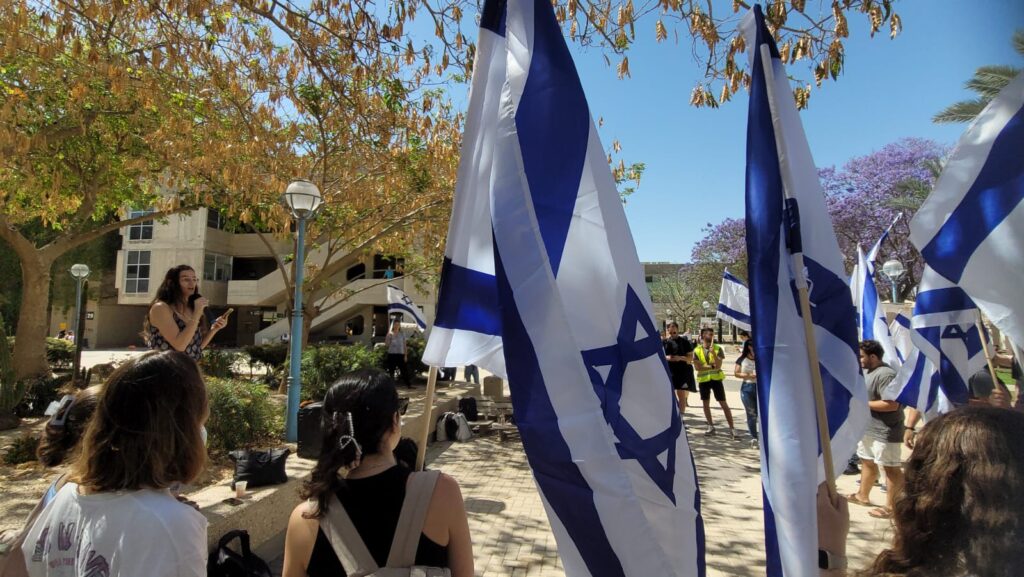Jewish Voice for Peace (JVP) is a self-described group of “Jews organizing toward Palestinian liberation and Judaism beyond Zionism.” The organization has chapters in major cities across the country as well as on a host of college campuses, including NYU, George Washington University, and Columbia University. On April 10, JVP published a post on its Instagram explaining the rationale behind its anti-Zionist ideology.
“We’re proud anti-Zionists at JVP,” the post declared. It went on to assert that “The Zionist movement embraced settler-colonialism,” arguing that “Zionism is a 19th century political ideology that claimed Jewish safety required a Jewish-only nation-state.” This allegation is not a new one; the assertion that Zionists are setter colonialists is a common one among Israel’s detractors. This narrative misrepresents the State of Israel by lumping it into a category to which it does not belong. Colonialism is primarily defined as the domination of a people or territory by a foreign power; a mother country sends colonists to establish themselves on foreign soil to bolster their economic prospects and exploit the local population. The more narrow settler colonialism adds another layer to the enterprise: “the complete destruction and replacement of indigenous people and their cultures by the settler’s own.”
One need only look to Israeli history to see that the Jewish state does not fit these criteria. There is no “mother count” that exported Zionist settlers; Jews who emigrated to Palestine came from a host of countries, and many, if not most of them did so to escape persecution and moreover, to return to their ancestral lands conquered by a series of Imperial powers. A cursory glimpse at contemporary Israel reveals that Zionism in no way sought a “Jewish-only state” and the destruction of the territory’s Arab people that would necessarily accompany such a reality. As a point of fact, had that been the goal, it would seem that it was an utter failure, with Arabs constituting 1 of every 5 Israeli citizens; according to 2021 numbers, Arabs make up over 21 percent of Israel’s population.
Moreover, Arab Israelis are granted equal rights, serve on the country’s highest court, and participate in academia, the military, and government. An examination of Israel also helps to counter the claim of settler colonialism. No colonial entity seeking the destruction of the other population present in the territory would accept a plan that establishes an independent state for them, as Israel did with the partition plan proposed by the United Nations in 1948; Zionist leaders were open to an Arab state established alongside their Jewish one while the Arab leadership of the region was adamantly opposed to even a dialogue.
In addition to its contrived settler colonialism claims, JVP likens Israel to Apartheid South Africa, writing: “In 1948, Zionist militias established a Jewish state on Palestinian land, instituted a military occupation over Palestinians, and mandated a system of Jewish legal supremacy — apartheid.” To equate Israel with the repressive white supremacy and segregation of pre-1990s South Africa demonstrates a lack of even a basic understanding of the events of the period. Apartheid South Africa stripped non-whites of suffrage, segregated public facilities, and banned interracial marriage; segregation was the very basis of governance, implemented and defended by the law. Israel has – and had – no such system. As touched upon earlier, Arab Israelis were granted recognized legal standing and equal rights under the law.
It cannot be denied that the situation of Israeli Arab citizens is not the same as their Palestinian counterparts in the West Bank and Gaza Strip. The reality that Palestinians face is a more complex one. The West Bank is primarily under the jurisdiction of the Palestinian Authority (PA), while Gaza is under the control of Hamas, an internationally recognized terrorist organization that seeks the destruction of the State of Israel.
Palestinian inhabitants of the West Bank are subject to checkpoints where the jurisdictions intersect, and limitations thus arise for security reasons. While its implementation has not always been perfect in a tiny country facing existential threats on a daily basis, it has exceeded the reality facing Arabs in neighboring countries.
The checkpoints present were not constructed in a vacuum; they are a result of decades of unending tensions brought about by terrorism in the region. Israeli citizens, unfortunately, face terrorism day after day. They are no strangers to random street stabbings, car ramming, shootings, bus bombings, and incendiary balloons launched into populated areas.
“Don’t be fooled by claims that Zionism is a movement for Jewish self-determination — it never was,” the JVP post went on to assert. “Despite hardship, diaspora Jews created thriving communities, cultural practices, and histories.” This ahistorical statement stands as an absurd commentary on the hideous events of the 19th and 20th centuries, affecting Jews of both Europe and the Arab world. I make no attempt to minimize diaspora Jewish communities, particularly because I am a part of one myself.
That being said, to discuss diaspora Jewry in the context of Zionism with no discussion of how the diaspora failed world Jewry in the era of Israel’s founding is to paint an incomplete picture in order to re-imagine events to serve their worldview. The Jewish state was established in the wake of the Holocaust; mass genocide in Europe and widespread persecutions of Jews of the Islamic world left Jews rightly feeling as though they no longer had a future as perpetual ‘guests’ living at the tender mercies of others. To argue that Jewish self-determination does not underpin Zionism is a blatant distortion of history, and I wish to play no part in deconstructing the past to fit a particular ideological narrative.
This article was originally published in the Algemeiner.

